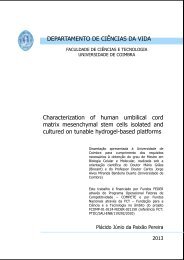Regulation of Apoptosis and Differentiation by p53 in Human ...
Regulation of Apoptosis and Differentiation by p53 in Human ...
Regulation of Apoptosis and Differentiation by p53 in Human ...
You also want an ePaper? Increase the reach of your titles
YUMPU automatically turns print PDFs into web optimized ePapers that Google loves.
CHAPTER 4: RNAi to explore role <strong>of</strong> <strong>p53</strong> <strong>in</strong> hESC<br />
However, there are a few upregulated genes that are known to have a pro-apoptotic role. NRGN<br />
(neurogran<strong>in</strong>), also known as RC3, a calcium/calmodul<strong>in</strong> b<strong>in</strong>d<strong>in</strong>g prote<strong>in</strong> can <strong>in</strong>duce <strong>in</strong>duction <strong>of</strong><br />
apoptosis due to cytok<strong>in</strong>e IL-2 deprivation <strong>in</strong> lymphoid cells (Devireddy <strong>and</strong> Green, 2003). In this<br />
model, levels <strong>of</strong> <strong>in</strong>tracellular Ca 2+ levels play a role <strong>in</strong> T-cell apoptosis. B<strong>in</strong>1 (bridg<strong>in</strong>g <strong>in</strong>tegrator 1)<br />
is a tumour suppressor that mediates apoptosis <strong>by</strong> <strong>in</strong>teract<strong>in</strong>g with c-myc (Sakamuro et al., 1996),<br />
is <strong>in</strong>volved <strong>in</strong> the negative regulation <strong>of</strong> progression through cell cycle <strong>and</strong> can <strong>in</strong>hibit<br />
transformation <strong>by</strong> mutant <strong>p53</strong> (Elliott et al., 1999). It has also been reported that B<strong>in</strong>1 participates<br />
<strong>in</strong> a caspase-<strong>in</strong>dependent cell death program (Elliott et al., 2000). These genes can be part <strong>of</strong><br />
simultaneous or alternative mechanisms to suppress the appearance <strong>of</strong> genetic abnormalities <strong>in</strong><br />
the hESC population.<br />
The biological processes <strong>of</strong> the genes downregulated <strong>in</strong> <strong>p53</strong> shRNA transduced cell l<strong>in</strong>es are<br />
genes <strong>in</strong>clude transport, regulation <strong>of</strong> transcription, nucleic acid metabolic process, cell cycle <strong>and</strong><br />
prote<strong>in</strong> am<strong>in</strong>o acid phosphorylation. Some <strong>of</strong> the downregulated genes can also contribute to<br />
tumorigenesis. NME1 (non-metastatic cells 1) which is <strong>in</strong>volved <strong>in</strong> negative regulation <strong>of</strong><br />
progression through cell cycle, was identified because <strong>of</strong> its reduced mRNA transcript levels <strong>in</strong><br />
highly metastatic cells (Driouch et al., 1998). CST6 (cystat<strong>in</strong> E/M) is a secreted <strong>in</strong>hibitor <strong>of</strong><br />
lysosomal cyste<strong>in</strong>e proteases <strong>and</strong> its loss <strong>of</strong> expression is likely associated with the progression<br />
<strong>of</strong> a primary tumour to a metastatic phenotype (Ai et al., 2006). TRIM22 (tripartite motif-conta<strong>in</strong><strong>in</strong>g<br />
22) is a <strong>p53</strong> target gene that confers reduced clonogenic growth <strong>and</strong> differentiation <strong>of</strong> leukemic U-<br />
937 cells (Obad et al., 2004). This expression <strong>of</strong> this gene has also been shown to <strong>in</strong>crease <strong>in</strong><br />
response to DNA-damag<strong>in</strong>g treatments <strong>in</strong> B-lymphoblastoid cell l<strong>in</strong>e TK6 (Amundson et al., 2005)<br />
<strong>and</strong> <strong>in</strong> response to cisplat<strong>in</strong> <strong>in</strong> TGCTs (Kerley-Hamilton et al., 2005). TMEM43 (transmembrane<br />
prote<strong>in</strong> 43) is another gene regulated <strong>by</strong> <strong>p53</strong> identified <strong>by</strong> a genome-wide analysis under hypoxic<br />
conditions (Hammond et al., 2006). Although the cell cycle <strong>in</strong>hibitor p21 (CDKN1A) prote<strong>in</strong> was<br />
not detected (section 3.9 <strong>of</strong> Chapter 2), levels <strong>of</strong> this <strong>p53</strong> downstream target <strong>in</strong>hibitor <strong>of</strong> cell cycle<br />
were found to be reduced <strong>in</strong> <strong>p53</strong> shRNA transduced cell l<strong>in</strong>es. On the other h<strong>and</strong>, Bax which was<br />
found to be downregulated <strong>by</strong> western blott<strong>in</strong>g analysis did not display differential expression on<br />
the microarray analysis. In order to validate these results Q-PCR should be performed.<br />
<strong>p53</strong> had a small but reproducible effect <strong>in</strong> <strong>in</strong>hibit<strong>in</strong>g spontaneous differentiation. Prelim<strong>in</strong>ary<br />
studies to address the role <strong>of</strong> <strong>p53</strong> <strong>in</strong> differentiation <strong>of</strong> hESC revealed a slight resistance <strong>of</strong> <strong>p53</strong><br />
shRNA transduced cell l<strong>in</strong>es to BMP4-<strong>in</strong>duced differentiation but the opposite was observed <strong>in</strong><br />
relation to Activ<strong>in</strong> A treatment, based on expression <strong>of</strong> Nanog <strong>and</strong> Oct4. Because these<br />
morphogens operate through different pathways, <strong>p53</strong> may participate differently <strong>in</strong> the<br />
differentiation process <strong>in</strong>duced <strong>by</strong> them. In GFP shRNA transduced cells <strong>p53</strong> levels decreased<br />
upon differentiation with BMP4. Perhaps more hESC differentiated progeny show regulation <strong>of</strong><br />
<strong>p53</strong> similar to somatic cells, where this tumor suppressor gene is kept at low levels. A very<br />
<strong>in</strong>terest<strong>in</strong>g study performed <strong>by</strong> Dazard <strong>and</strong> colleagues (Dazard et al., 2000) explored the<br />
<strong>p53</strong>/MDM2 regulatory loop dur<strong>in</strong>g different transitions <strong>of</strong> the human epidermal differentiation<br />
program. They showed that maximum expression <strong>of</strong> <strong>p53</strong> was found <strong>in</strong> proliferat<strong>in</strong>g kerat<strong>in</strong>ocytes<br />
<strong>and</strong> that a transient <strong>in</strong>duction <strong>of</strong> MDM2 <strong>and</strong> a downregulation <strong>of</strong> <strong>p53</strong> characterized the transition<br />
- 116 -
















